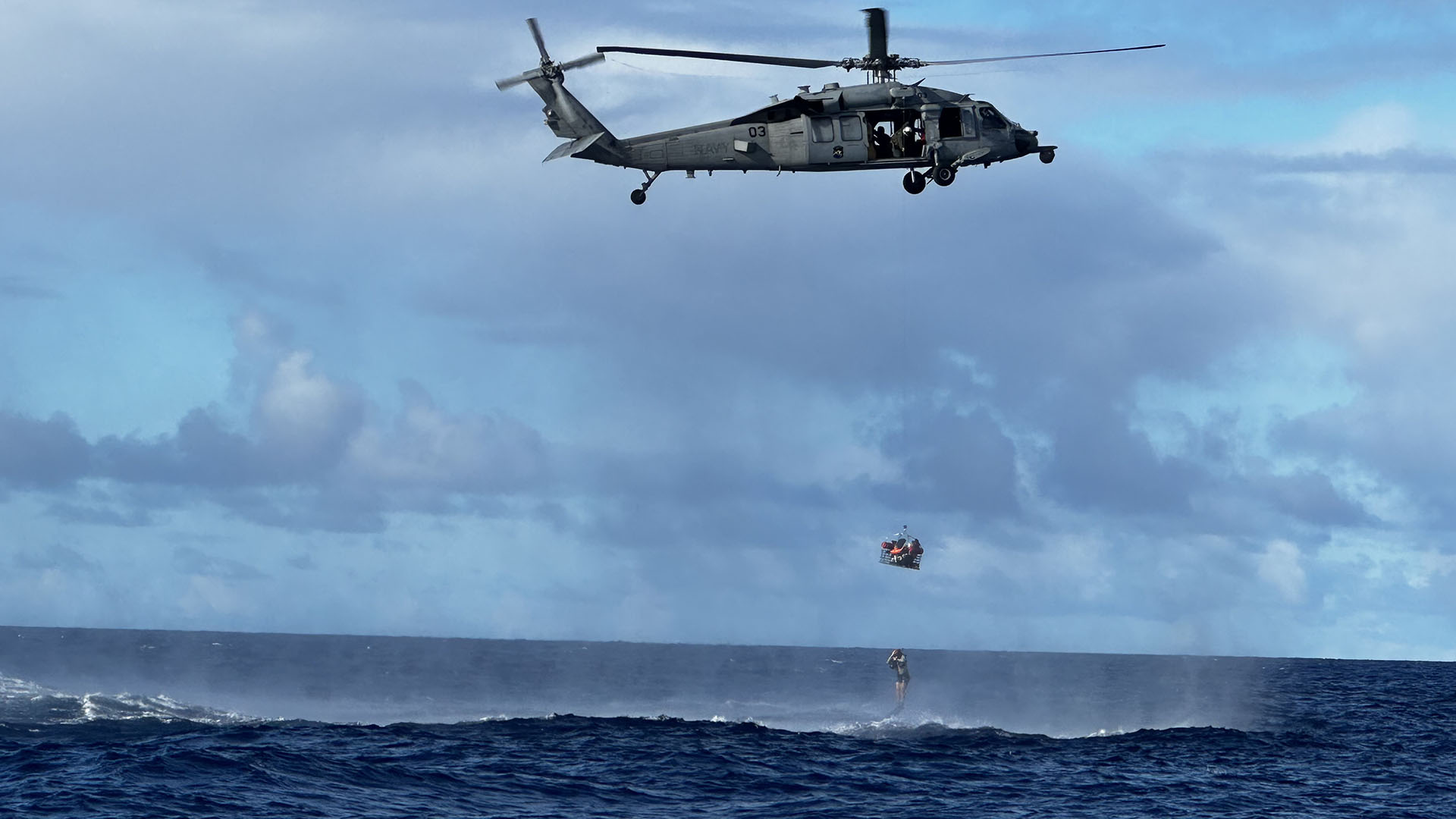

The Coast Guard used a high tech tracking buoy to help a Navy helicopter search the right area to find three missing scuba divers, who had drifted away from their dive boat off the coast of Guam, Coast Guard and Navy officials said.
Sailors with the Navy’s Helicopter Sea Combat Squadron 25 recently plucked three divers from the Pacific Ocean after they went missing about 29 miles off the coast of Guam, a Coast Guard news release says.
With this rescue, the helicopter squadron has saved the lives of 33 people so far this year, according to the Navy.
“Open ocean rescues are inherently dynamic and require abundant concentration from the entire crew,” said Navy Cmdr. Neil Toohey, commanding officer of Navy’s Helicopter Sea Combat Squadron 25. “This was an excellent example of teamwork and professionalism that ultimately had the outcome we wanted – three lives saved. We are proud to partner with USCG Forces Micronesia to serve the citizens of Guam and the Commonwealth of the Northern Mariana Islands.”
On Oct. 28, Joint Rescue Sub-Center Guam received a distress call from the operator of a dive boat, who said the three divers had not surfaced at the agreed upon time two hours earlier, the news release says.
Subscribe to Task & Purpose Today. Get the latest military news and culture in your inbox daily.
The three men were experienced divers who had planned to surface together in case of an emergency. They were described as wearing distinctive bright t-shirts, diving lights, and “safety sausages,” inflatable markers that signal that divers are below.
Vince Grochowski with the Coast Guard was serving as lead command controller for the Joint Rescue Sub-Center Guam when the distress call came in. The dive boat was able to send messages but not receive any, so the Coast Guard was unable to communicate with the boat, he said.
“They kept relaying different pieces of information and then kept asking if anyone is hearing this call to contact the Coast Guard,” Grochowski said. “We continued to try to get contact with them and could not make contact with them for whatever reason.
The Joint Rescue Sub-Center Guam team, a 45-foot Response Boat-Medium from U.S. Coast Guard Station Apra Harbor, and Helicopter Sea Combat Squadron 25 all immediately launched a search and rescue operation.
It is very difficult for rescuers to spot missing divers because the only part of their bodies above water is their heads.
Adding to the urgency of this rescue, the dive boat sent a message that it was going to leave the scene and come in closer to shore in an attempt to call the Coast Guard on a cell phone, Grochowski said.
“We were concerned that they were departing the site leaving three people out there, but we already had assets out there,,” Grochowski said.
Coast Guard Petty Officer 2nd Class Oliver Menet was the operator of the 45-foot boat dispatched to look for the three divers. He and the rest of the boat’s crew immediately understood the seriousness of the situation and worked as quickly as possible to get to the divers’ last known location.
“We were the first on scene,” Menet said. “We immediately went to the spot the divers entered the water and deployed a [SLDMB or self-locating datum marker buoy], which is basically a data marker buoy that gives the set drift, the direction and how fast the person is drifting, based on where they entered the water, to give us a better estimated position of where they would end up.”
Coast Guard officials overseeing the search used the buoy’s information to develop search patterns for both the Coast Guard boat and Navy helicopter, Grochowski said.
Roughly two hours after the three men were reported missing, the crew of a Navy MH-60 Knighthawk helicopter spotted the divers waving their safety sausages, said Naval Aircrewman 2nd Class Ryan Horn, a rescue swimmer.
Horn was lowered into the water by Naval Aircrewman 2nd Class Daniel Perez where he found that none of the divers were injured. He then moved the three men to the helicopter’s rescue basket.
“I first secured the survivors in the basket then loaded the BCD [Buoyancy Compensator Device] in with each survivor,” Horn said. “The entire recovery of three survivors was completed in 10 minutes.”
Once they were aboard the helicopter, Hospital Corpsman 2nd Class Theodore Burns determined the divers had no major injuries, according to the Navy. The three men were then taken to U.S. Naval Hospital Guam for further evaluation.
Menet said he and the rest of the crew of the 45-foot boat were excited that the Navy helicopter had found the divers.
“We heard the call over the radio, saw the helo lining up for their approach, and immediately went over there just in case anything were to happen or if we needed to retrieve gear,” Menet said. “They told us we’re good, to just stand by.”
Menet then took two photographs of the MH-60 hoisting the three men aboard the helicopter.
“We were obviously happy that they were found,” Meent said. “In the end, it was a good day.”
The latest on Task & Purpose
- Marines investigating video in which man claims body buried at Camp Lejeune
- The best MRE of the War on Terror, according to combat veterans
- 19 US troops have Traumatic Brain Injury after drone attacks in Iraq and Syria
- US expects Iran to continue to escalate Israel/Hamas war
- Fort Liberty special operations soldiers arrested for drug possession